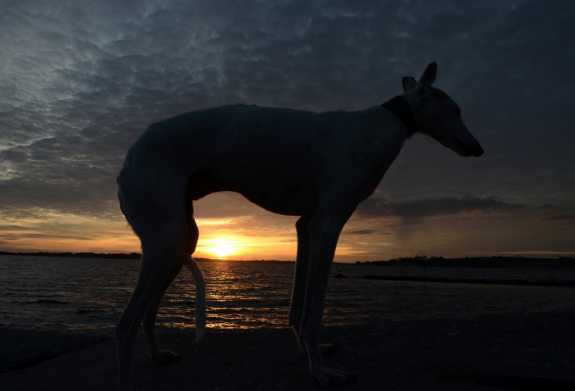
Of the podenco breeds, perhaps the least is known about the Podenco Malagueño and the Podenco Orito, but in this continuing series on podenco breeds, we share what little we were able to find on the Malagueño. Photos in particular were hard to find, and as we lack permission to share the ones we did locate, click here to see one.
A reminder that a podenco is a hare-hunting breed, podenco meaning “hound.” But first, a little mood music:
You may have recognized the song made famous by the movie, “Ten,” “Malagueña” (a tune often performed in drum and bugle corps and marching competitions). Written byErnesto Lecuona, it was originally the sixth movement of his Suite Andalucía. It also refers to a flamenco dance style from Málaga in the southeast of Spain. The mention of Málaga brings us to the Podenco Malagueño, a breed that hails from that province in Spain.
Like all podencos, the Malagueño has large prick ears, and he has similar coloring to other podencos. Using his prodigious senses of smell, sight and hearing, the Malagueño successfully locates hares in the deepest of hidey holes. Despite many similarities, however, the Podenco Malagueño is its own breed which was determined by research showing a unique and specific breed pattern. Reference can be made to two important dates in the recent history of dog breeds: National Symposium of Spanish Dog Breeds in 1982 and the International Symposium of Spanish Dog Breeds in 1992.
Phoenician merchants likely brought podenco-type dogs to the Mediterranean as far back as the 8th century BC. As the dogs were taken into different parts of Spain, different types of podencos emerged, each “tailored” to hunt in the particular terrain of their home, and named for the area where they developed. The Malagueño was well suited to hunt in the rocky topography of Málaga situated on the Mediterranean coastline close to the Malaga Mountains. As such, this podenco is a bit more robust, but as serious about hunting as the other podenco breeds, and with a skill set better adapted to hunting on hard, dry ground. He works with his head “half mast” down without touching the ground, and trots slowly in zigzag fashion, back and forth, his tail movement telegraphing his progress in detecting game. At the risk of being too vivid, the Malagueño removes the need for a shotgun by catching a rabbit with his teeth.
The Malagueño is not internationally recognized,
There is an amazing document written by Edwin Verhaegen, Founder and Treasurer of Podencoworld Foundation, and translated by Nicole den Broeder. The twenty-two page paper is well worth the read, and has many good photographs, but frank in its evaluation (none of the photos, by the way, are of a graphic nature. Though some show the sheer number of these dogs, they’re otherwise safe to view). We saw no copyright on the paper, but it would be a disservice to borrow from it beyond sharing its interesting opening paragraph:
Spain owed its name to the rabbit. When the Phoenicians reached the Iberian Peninsula around 11th century B.C., they found many rabbits there. Because they thought the animals looked very similar to what for them is known as a Saphan, they named the region ‘I-saphan-im’, land of the Saphan. The Romans later renamed it to ‘Hispania’. Originally the rabbit only occurs on the Iberian Peninsula. If Spain was already named Hispania by the Romans, which means ‘land of rabbits’, then it was inevitable that in this Hispania the most relevant dog breed, the Podenco appeared, a specialist in rabbit hunting. Ever since, the Podenco is the most commonly used hunting dog in Spain, for this reason we could easily rename Spain the Podenco land.
Image of a Podenco by © Kim Christensen | Dreamstime

I didn’t know this hound existed. Thanks for bringing it to light!
Mission accomplished (grin)!